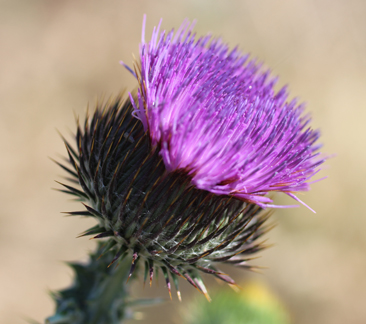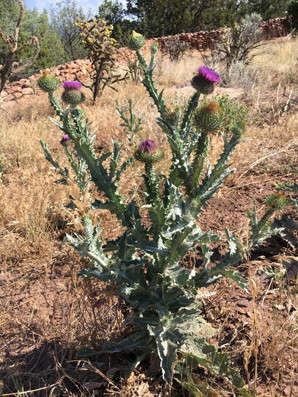
Location
Near #4 before South Pueblo ruins (N35D33'05.609 X W105D41'22.752) and between #8 & #9 (N35D33'12.372 X W105D41'25.962)
Flowers first observed: 6/21/17
The Plant w/Flowers
The Flower

Distribution
"It is a biennial plant, producing a large rosette of spiny leaves the first year. The plants typically germinate in the autumn after the first rains and exist as rosettes throughout the first year, forming a stout, fleshy taproot that may extend down 30 cm or more for a food reserve.
In the second year, the plant grows (0.2–) 0.5–2.5 (–3) m tall and a width of 1.5 m. The leaves are 10–50 cm wide, are alternate and spiny, often covered with white woolly hairs and with the lower surface more densely covered than the upper. The leaves are deeply lobed with long, stiff spines along the margins. Fine hairs give the plant a greyish appearance. The massive main stem may be 10 cm wide at the base, and is branched in the upper part. Each stem shows a vertical row of broad, spiny wings (conspicuous ribbon-like leafy material), typically 2–3 cm wide, extending to the base of the flower head.
The flowers are globe shaped, 2–6 cm in diameter, from dark pink to lavender, and are produced in the summer. The flower buds form first at the tip of the stem and later at the tip of the axillary branches. They appear singly or in groups of two or three on branch tips. The plants are androgynous, with both pistil and stamens, and sit above numerous, long, stiff, spine-tipped bracts, all pointing outwards, the lower ones wider apart and pointing downwards. After flowering, the ovary starts swelling and forms about 8,400 to 40,000 seeds per plant.[4][5][6]" (Wikipedia)
Description
"Cotton thistle is native to Europe and Asia. The plant prefers habitats with dry summers, such as the Mediterranean region, growing best in sandy, sandy clay and calcareous soils which are rich in ammonium salts. It grows in ruderal places, as well as dry pastures and disturbed fields. Its preferred habitats are natural areas, disturbed sites, roadsides, fields, and especially sites with fertile soils, agricultural areas, range/grasslands, riparian zones, scrub/shrublands valleys and plains along with water courses.[1][4] Temperature and moisture, rather than soil nutrient concentrations, determine the ecological performance of Onopordum species.[7]
In Europe, the plant tends to colonise disturbed pastures. In its native range, cotton thistle is considered a weak competitor that needs regeneration gaps to develop and maintain stands; populations tend to retreat when disturbance ceases.[8] The plant has been widely introduced at mid-latitudes across much of North America.[9]" (Wikipedia)
Ethnobotanical Uses
Medicine:
"Iroquois Emetic Decoction used as an emetic to counter witchcraft. Poison Decoction used for witchcraft poison. ---" (Moerman 363)
